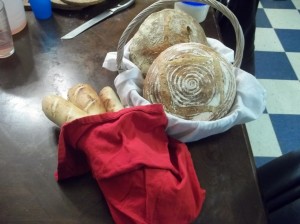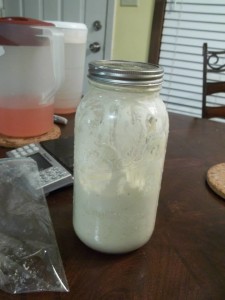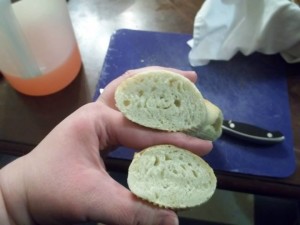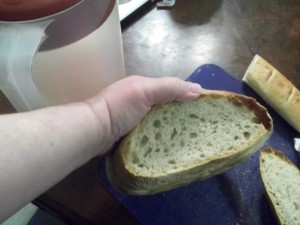Baking is chemistry and biology and math all rolled up into one and it produces yummy things to eat. What more could a nerdy girl want?
Sourdough is wonderful stuff. It seems sort of magical to me. You take water and flour and stick them together. And then you add more water and flour. And more water and flour and before you know it, you’ve got this stuff that will make bread rise. This is fascinating to me. But, then, so is most of baking.
When I decided to do sourdough, I looked at about a million and a half ways to make a starter. Some of them had half a dozen or more ingredients to get started and they seemed like they were just a little too fussy. The simplest ones had just two ingredients (flour and water) and a couple had just three or, at most, four. I ended up using a hybrid of a couple different starter methods.
Before I go into what I did and why, I’m going to give a quick rundown on why sourdough actually works.
Most yeast-risen breads use some sort of commercial, storebought yeast. It comes in little packets or jars (or if you’re like me in one-or-two-pound bricks), it’s pretty inexpensive, and it’s generally foolproof if you pay attention to the dates on the container. Sourdough, on the other hand, relies on wee beasties that are living naturally on flour and in the air. They’re just about everywhere and they just need a little care and feeding before you can harness them to do your bidding.
These wee beasties are wild yeast and bacteria that produce lactic acid, which is what produces that tang that makes sourdough, well, sour. Wild yeast is pretty much everywhere. It’s even living on most flour, but some flours have more than others. Unbleached flours are good. Whole grain flours are better.
For my starter, I used rye flour for the first two feedings, since I had some sitting around from my pumpernickle and rye experiments and because being unbleached and whole grain, it had the highest yeast content. I also used about a tablespoon of unsulphured molasses to jumpstart the wee beastie feeding frenzy that would eventually let me use this to make bread.
Every recipe and method I read stressed the importance of a non-reactive container, so I got out one of those trusty half-gallon Ball jars. We’ve got a few of these in different sizes for various functions. Half-pints for refrigerator oatmeal. Quarts for mixes and plain old drinking. Half-gallons for things that are too big for the quarts, like cocoa and sourdough starter.
I started out with 3/4 cup rye flour and 1 cup of filtered, lukewarm water. I poured in the molasses, mixed using a silicone spatula that reached all the way to the bottom of the jar, closed the lid, and popped the jar on top of the fridge for warmth, since I was starting this mid-winter when our kitchen was shall we say less than balmy.
The second day, I poured off about half the mixture, added a cup of rye flour and a cup of lukewarm filtered water, mixed, lidded, and back on top of the fridge.
From there on out, I used unbleached all purpose flour to feed the starter.
By about day four, I could smell that sourdough smell and got really excited. That’s when I started not wanting to actually throw out the discarded starter, so we poured some of it into screw-top plastic containers and stashed them in the fridge. That got turned into sourdough pancakes later. They were popular enough that I have started keeping a small stash of ripe starter just so we can do that again.
The thing with sourdough starter is that you can just keep feeding it and not discard any, but if you do that, you had better be able to bake every few days, or you’re going to end up with a five-gallon drum of sourdough starter that will be all bubbly and active and look like it’s going to threaten to take over your entrire house, something like a carbohydrate version of The Blob.
On days 4-6, I started twice-a-day feedings of the starter. Day 7, there was a little bit of an issue. The starter had started to smell sort of beery, rather than tangy and sourdough-y. It wasn’t a horrible smell, just more sharp than I was expecting. I continued with twice-a-day feedings for the next couple of days until I had a chance to bake.
The first sourdough experiment was to try two different recipes for sourdough and see which one was preferred by the family.
I used the pain au levain recipe from the King Arthur Baker’s Companion for two of the loaves and the basic sourdough recipe from The Bread Baker’s Apprentice for the other two. The KABC loaves became boules and the BBA loaves were made, more or less, into baguettes.
The BBA recipe calls for an overnight pre-ferment, so I took part of my sourdough starter and created a sponge, which I let sit out until it had gotten nice and bubbly and had expanded. Then it got stuck in the fridge for an overnight cold ferment.
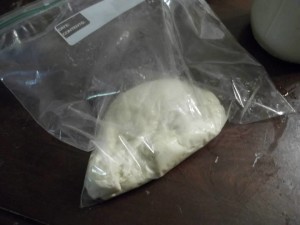
The next day, I got that out of the fridge to take the chill off while I started the KABC recipe. I managed my timing pretty decently that day, but that was pretty much an accident. I’m still learning to juggle timing on cooking and baking especially.
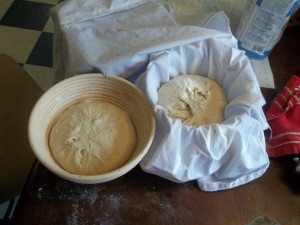

The main element to making sourdough bread appears to be patience. You wait a week for your starter to be ready. Because wild yeast aren’t quite as gung-ho as commercial yeast, you end up spending a lot more time with the bread rising. You have to be careful with it during shaping and proofing because of that slow rise, you don’t want to degas it too much. It’s also a ‘the wetter the better’ sort of dough, which can make the first stages of mixing and proofing look lumpy. And it sticks to your fingers like you wouldn’t believe.
In the end, it’s worth it. The baguettes came out pretty well despite obviously being the first ones I had ever shaped. The boules came out with a gorgeous, airy crumb and I have been reliably informed that they made the best French toast in the universe. The bread had a delicate sourdough scent, but wasn’t all that sourdough-y in flavor. Later, I found out that was because of the beer-y smell in the starter. The yeast had begun to overproduce and it basically over-fermented. I found a way to ‘sweeten’ the starter and it no longer has that sharp scent.
The second batch came out with a better flavor and the third batch is upcoming this week. I’ve been told that sourdough starter just gets better as it ages, so I’m interested to see how that goes as I continue using it.
The leftover starter that was set in the fridge just at the peak of ripeness was used to make sourdough pancakes. Those, apparently, tasted deliciously tangy and just as everyone felt sourdough should taste.
